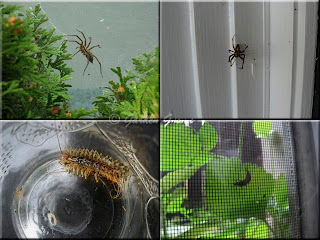We have creepy crawlies! This is to be expected living on the water in a house surrounded by lush vegetation. Given our house is earth bermed with at least three windows at ground level and patio doors, the conditions are very favourable for insects getting indoors. For the most part I do not mind creepy crawlies in the garden but I do mind them in the house. As with any pest whether in the garden or house the first step is identifying to determine if they are beneficial or harmful. The second step is removal if harmful, poisonous or invading the house. The third step is prevention. Creepy Crawlies
Creepy Crawlies
There are several spider species here ranging from very small to a couple of larger, ominous looking ones. Daddy Longleg and Cobweb (Pholcus phalangioides) spiders are quite abundant as well (not pictured). I think the smaller one on the right is a Domestic Spider (Achaearanea tepidariorum) a common but harmless spider found around the home. I haven't identified the larger spider on the left yet. We also have centipedes that do have a poisonous bite, menacing looking earwigs, pillbugs and numerous smaller beetles.
For the most part, identification has been made. This is important when mounting a plan of attack with prevention being a key part of the attack. Spiders almost always construct their webs in areas where there is a draft. Centipedes are predators to spiders so eliminate the spiders and the centipede go away. Earwigs and centipedes like moist, dark areas. I'm not sure what attracts pill bugs as they just seem to march along. Ants are generally attracted by a food source.
My plan of attack after identification starts with elimination. This means removing any and all creepy crawlers usually by manual methods. Any heavy infestations may need to be controlled by chemical means. The next step is prevention which includes eliminating food sources, hiding spots, nesting areas, along with any other attractors as well as sealing entry points. The following highlights some of the measures I'm taking for our situation. It will be an ongoing project that will require constant vigilence but less action over time.
Materials Needed:
- glass jars with lids
- paintable caulk
- caulking gun
- expandable spray foam
- broad spectrum insecticide (Bio-Mist by green earth)
- specific insecticides (Spider Ban by CIL, Raid Max by Johnson)
- pressurized sprayer
- safety equipment - mask, disposable gloves
Elimination Methods:
If the insect is something harmless like a cricket then the easiest thing to do is catch it an release. It is quite helpful to mark any entry points if you can see them. In the case of spiders I always tag the area with a post-it note before removing the spider. These are areas where air is infiltrating so need further attention. A vacuum cleaner is ideal for sucking up these kinds of critters too whether dead or alive. If need be use a spray like Raid Max to quickly kill off larger numbers of the creepy crawlies but only use this method if you can't eliminate them manually without chemicals. One creating but satisfying gadget is the Bug Zapper.
 Bug Zapper
Bug ZapperI have a hand held bug zapper as one way to manually take care of creepy crawlies. This is a nifty little gadget When the button on the side is pushed the wires electrocute the insect that can then be vacuumed up. Warning: This gadget looks like a toy but should be kept well away from children. It can do serious harm. Never touch the metal wire whether the unit is on or not. For your protection ground the unit before storing. Ok, so that's the high tech, slightly sadistic way of dealing with creepy crawlies and it does work.
Prevention:
The first rule of thumb is to keep the invaders out. Build up your defenses so they can't get in and if they do the environment is such that they will want to move on.
little things: I'm very careful to hang anything that is wet or damp whether it is for the laundry or not. If left on the floor or laundry hamper it provides the perfect spot for earwigs. I store all dried foods in sealable glass containers that prevent any pests from getting into. The kitchen floor and countertops are kept squeeky clean. Garbage is taken out nightly. I also careful to vacuum regularily something that would be done anyway.
sprays: Once you have the creepy crawlies out of the house you want to prevent more from getting in. I use a few methods for this. Spiders can be controlled indoors and outdoors by using a product called SpiderBan by CIL, a rapid knock-down product. This product contains Permethrin and while it has low mammalian toxicity, caution is needed. There is a residual effect so it keeps working after dry. To use dilute 20 ml into 1 L of water. Put it in a sprayer and spray areas until wet. Indoors focus on baseboards, cracks or other areas where spiders hide. I decided not to use this product indoors if at all possible but I did use it outdoors spraying liberally the areas around windows and doors as as any areas that I found spiders on the house. I plan on repeating this treatment at least once before the cold weather sets in. Bio Mist, a broad spectrum and rapid knock-down product by earth green is ideal for controlling centipede and earwig infestations. It is used much the same way as SpiderBan is used except it is for outdoor treatment. Remove any decaying vegetation. Mulched areas near the house should be sprayed as should bushes. Special attention should be paid to cracks and crevices. If the infestation is bad, call in a pest control company that will do a knock-out then proceed to preventing further infestations. Note: When using sprays follow the instructions and use safety equipment.
sealing: Cracks, holes and gaps allow insects and other pests to enter your home. At the same time they cost you money by letting causing drafts and letting heating air out. So it makes good economical sense all the way around that these entry points need to be sealed. The easiest way to do this is to caulk. Keep a tube of caulk ready to go so that you can seal cracks as you notice them. Outside, remove old caulk and re-caulk. Pay special attention to gaps around pipes or wires entering the house. For larger cracks or gaps, use and expandable spray foam.
We have already noticed a dramatic decrease in spiders and centipedes in the house using these methods. I'm sure I hit at least one breeding spot for the centipedes as since spraying we've found two dead and two alive. The last one is thought to have come in through the kitchen window left open at night. It's at ground level and the centipede was in the sink. I've since sprayed the area around the kitchen window again and so far no other centipedes have been spotted. With diligence I'm sure we can keep the creepy crawlers out in the gardens where they belong!
Garden Gnome
© 2007
















